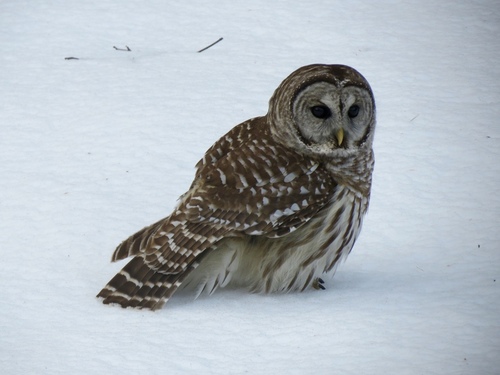
Barred Owl
The Barred Owl (*Strix varia*) is a large, stocky owl native to North America, easily recognized by its mottled brown and white plumage and distinctive "who-cooks-for-you, who-cooks-for-you-all" hooting call. It plays a crucial role in forest ecosystems as an apex predator, primarily controlling rodent populations. While not currently considered globally threatened, the Barred Owl faces increasing pressure from habitat loss and competition with other owl species. It holds some cultural significance, often associated with wisdom and mystery in folklore, though less prominently than some other owl species.
40-63 cm
Length
96-125 cm
Wingspan
Least Concern
Conservation Status
Distribution
Primarily found in eastern and central North America, from southern Canada down to the southeastern United States. Its range has been expanding westward in recent decades, reaching the Pacific Northwest. It does not typically undertake long-distance migrations, but individuals may move locally in response to food availability.
Lifespan
Up to 10 years in the wild; longer in captivity (up to 24 years recorded).
Barred Owl's Habitat
Habitat Types
Mature forests, Wooded swamps, Riverine forests, Mixed woodlands
Climate Zones
Temperate, Subtropical
Adaptations
Barred Owls have excellent low-light vision and hearing, allowing them to hunt effectively in dense forests. Their feathered legs provide insulation in colder climates. They are adaptable to a range of forest types, provided there are suitable nesting cavities and prey.
Variations
Several subspecies are recognized, including *Strix varia varia* (Northern Barred Owl), *Strix varia georgica* (Florida Barred Owl), and *Strix varia helveola* (Texas Barred Owl). These subspecies show slight variations in size and plumage coloration.
Appearance
Breeding Plumage
Plumage remains relatively consistent throughout the year.
Seasonal Feather Changes
Minimal seasonal variation; may appear slightly paler after molting.
Sex Based Plumage Differences
Males and females have similar plumage patterns, with mottled brown and white barring on the chest and streaking on the belly.
Notable Features
Large, round head without ear tufts, Dark brown eyes, Horizontal barring on the chest and vertical streaking on the belly, Feathered legs
Diet and Feeding
Primary Foods
Small mammals (mice, voles, squirrels), Birds, Amphibians, Reptiles, Invertebrates
Foraging Behavior
Primarily a nocturnal hunter, often perching and waiting for prey to pass by. It uses its excellent hearing and vision to locate prey, then swoops down silently to capture it with its talons. Also known to hunt during the day, particularly during nesting season.
Specializations
Barred Owls have asymmetrical ear openings, which help them pinpoint the location of prey by sound. Their soft feathers allow for near-silent flight, enabling them to surprise prey.
Seasonal Diet Variations
Diet may shift slightly depending on prey availability. For example, they may consume more amphibians in spring and summer when these prey are more abundant.
Behavior
Social Structure
Generally solitary or found in pairs, except during the breeding season. They are not known to form large flocks.
Communication
Distinctive "who-cooks-for-you" hooting call, Variety of other vocalizations, including barks, cackles, and screams, Visual displays, such as bowing and wing-flapping
Migration
Barred Owls are generally non-migratory, but individuals may disperse locally in search of food or suitable habitat. Young birds may disperse further from their natal territory.
Territorial or Group Behaviors
Barred Owls are highly territorial, defending their nesting and hunting areas from other owls. They will aggressively chase away intruders, often using vocalizations and physical displays.
Conservation
Threats
Habitat loss (deforestation), Competition with Great Horned Owls and the expanding range of the Barred Owl itself into new areas, Collisions with vehicles, Secondary poisoning from rodenticides
Protection Programs
Forest management practices that preserve mature trees and snags, Protection of wetlands and riparian areas, Public education about the importance of owls and responsible rodent control
Local National Laws
Protected under the Migratory Bird Treaty Act in the United States.
Population Trend
Generally stable, but with some regional declines and expansions.
Population Estimates
Estimated global population of around 3 million individuals.
Interesting Facts
Barred Owls can turn their heads up to 270 degrees.
This allows them to scan a wide area for prey without moving their bodies.
They are known to occasionally prey on other owls.
Including smaller owl species, and sometimes even other Barred Owls.
Barred Owls have been expanding their range westward, leading to increased competition with the endangered Spotted Owl.
This hybridization and competition pose a significant threat to Spotted Owl populations.
Faqs about Barred Owl
What should I do if I find an injured Barred Owl?
Do not approach the owl. Contact a local wildlife rehabilitator or animal control agency for assistance. *Consult a professional for expert advice.*
Are Barred Owls dangerous to humans?
Barred Owls are not typically aggressive towards humans, but they may defend their nests or young if they feel threatened. It's best to observe them from a safe distance.
How can I attract Barred Owls to my property?
Maintaining mature trees and providing a source of water can make your property more attractive to Barred Owls. However, it's important to avoid using rodenticides, as these can poison owls.
Do Barred Owls mate for life?
Barred Owls are believed to form long-term pair bonds, and may mate for life, though more research is necessary for definitive conclusions.
Copyright @ Nature Style Limited. All Rights Reserved.
 English
English